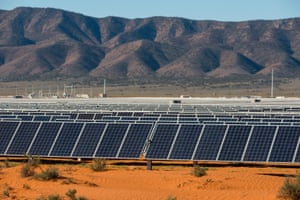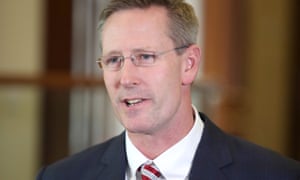Extract from The Guardian
Liberal energy minister, who inherited policy criticised as a mix of
‘ideology and idiocy’, says he’ll ensure it does not come at too high a
price
South Australia’s energy minister says the state is on track to have
75% of its electricity from renewable sources by 2025 – the target set
by the former Labor premier Jay Weatherill and once rejected by his
Liberal government.
And Dan van Holst Pellekaan pledged to ensure it does not come at too high a price.
The Liberal party was highly critical of Weatherill’s target when it was announced during this year’s South Australian election campaign, with the then state opposition leader, Steven Marshall, pledging to scrap it and the federal energy minister, Josh Frydenberg, likening the then premier to a clean energy addicted gambler “doubling down to chase his losses”. Prime minister Malcolm Turnbull had earlier described Weatherill’s renewable energy policy as “ideology and idiocy in equal measure”.
But several expert analyses have found the state is likely to meet or nearly meet the aspirational target, which was not tied to a policy mechanism. The Australian Energy Market Operator has projected South Australia would have 73% renewable power by 2020/21 while consultants Green Energy Markets found it could reach 74% by 2025 without any additional policies being introduced.
The South Australian energy and mining minister, Dan van Holst Pellekaan, said that was also his understanding. “That’s what the reports I’ve read are saying,” he said. “We need to harness it properly so consumers aren’t paying too high a price along the way.”
Van Holst Pellekaan has responsibility for shaping the future of energy in a state that already gets about half its electricity from variable sources such as wind and solar – a situation that Weatherill described in 2015 as “a big international experiment”. The new minister has inherited some of Labor’s proposed solutions, including a giant lithium-ion battery, a 20-year power purchase contract to underwrite a solar thermal plant with built-in storage and a “virtual power plant” of solar and batteries across public housing sites.
"We must transition away from fossil fuels towards renewable energy ... And we need to do it sensibly."
He assumed the energy portfolio in March amid intense debate over the future of the national electricity market, which connects the four eastern states and South Australia. Frydenberg is attempting to design the government’s national energy guarantee policy so that it can win backing from the states, the Coalition party room and federal parliament. Labor wants it to allow a future government to ramp up the proposed 2030 emissions target for the electricity grid of a 26% cut below 2005 levels. Some federal Coalition members want taxpayers to support or underwrite new or existing coal-fired power plants.
Speaking in his electorate office in Port Augusta, home to the state’s coal power until the last plant closed in 2016, and now with up to 13 clean energy at varying stages of development including the solar thermal project, van Holst Pellekaan said the shift from coal to more clean energy in South Australia had been messier than it needed to be, but was inevitable.
“We must transition away from fossil fuels towards renewable energy,” he said. “There’s no doubt about it. And we need to do it sensibly.”
He said he believed the former ALP government had made a mistake in not paying Alinta Energy the $24m it had requested to keep the Northern coal plant at Port Augusta open for another three years while more renewable energy was built as it would have avoided “an enormous amount of pain” in local job losses and a spike in the wholesale electricity price.
“Many of my friends who are incredibly strong proponents of renewable energy disagree with me,” he said. “They say, ‘No mate, just shut it as soon as possible. Who cares what the price is?’ The ‘Who cares what the price is?’ part is where I differ.”

And Dan van Holst Pellekaan pledged to ensure it does not come at too high a price.
The Liberal party was highly critical of Weatherill’s target when it was announced during this year’s South Australian election campaign, with the then state opposition leader, Steven Marshall, pledging to scrap it and the federal energy minister, Josh Frydenberg, likening the then premier to a clean energy addicted gambler “doubling down to chase his losses”. Prime minister Malcolm Turnbull had earlier described Weatherill’s renewable energy policy as “ideology and idiocy in equal measure”.
But several expert analyses have found the state is likely to meet or nearly meet the aspirational target, which was not tied to a policy mechanism. The Australian Energy Market Operator has projected South Australia would have 73% renewable power by 2020/21 while consultants Green Energy Markets found it could reach 74% by 2025 without any additional policies being introduced.
The South Australian energy and mining minister, Dan van Holst Pellekaan, said that was also his understanding. “That’s what the reports I’ve read are saying,” he said. “We need to harness it properly so consumers aren’t paying too high a price along the way.”
Van Holst Pellekaan has responsibility for shaping the future of energy in a state that already gets about half its electricity from variable sources such as wind and solar – a situation that Weatherill described in 2015 as “a big international experiment”. The new minister has inherited some of Labor’s proposed solutions, including a giant lithium-ion battery, a 20-year power purchase contract to underwrite a solar thermal plant with built-in storage and a “virtual power plant” of solar and batteries across public housing sites.
"We must transition away from fossil fuels towards renewable energy ... And we need to do it sensibly."
He assumed the energy portfolio in March amid intense debate over the future of the national electricity market, which connects the four eastern states and South Australia. Frydenberg is attempting to design the government’s national energy guarantee policy so that it can win backing from the states, the Coalition party room and federal parliament. Labor wants it to allow a future government to ramp up the proposed 2030 emissions target for the electricity grid of a 26% cut below 2005 levels. Some federal Coalition members want taxpayers to support or underwrite new or existing coal-fired power plants.
Speaking in his electorate office in Port Augusta, home to the state’s coal power until the last plant closed in 2016, and now with up to 13 clean energy at varying stages of development including the solar thermal project, van Holst Pellekaan said the shift from coal to more clean energy in South Australia had been messier than it needed to be, but was inevitable.
“We must transition away from fossil fuels towards renewable energy,” he said. “There’s no doubt about it. And we need to do it sensibly.”
He said he believed the former ALP government had made a mistake in not paying Alinta Energy the $24m it had requested to keep the Northern coal plant at Port Augusta open for another three years while more renewable energy was built as it would have avoided “an enormous amount of pain” in local job losses and a spike in the wholesale electricity price.
“Many of my friends who are incredibly strong proponents of renewable energy disagree with me,” he said. “They say, ‘No mate, just shut it as soon as possible. Who cares what the price is?’ The ‘Who cares what the price is?’ part is where I differ.”

“For us, I think a three-year phase-in [of replacing coal] would have been fine. Nationally, maybe we’re looking at a 10- or-20-year phase-in. I’m comfortable there’s no more coal-fired electricity in South Australia – very comfortable – we just should have made the transition better.”
Van Holst Pellekaan said gas-fired electricity, a fossil fuel with lower emissions than coal, would have a slower decline, predicting it would take “a couple of decades”. Rather than traditional baseload gas that runs constantly, he said the focus would be on peaking gas plants – fast-start generators that sit idle until needed at times of peak demand – to fill the gaps around renewable energy.
He agreed with the federal government that policy should be “broadly technologically neutral” but said it needed to place a value on three goals – keeping consumer costs down, delivering non-polluting technology and improved efficiency within the national market. “That steers you towards large-scale renewables with large-scale storage and an underlying security that comes from peaking gas plants,” he said.
South Australia is also backing small-scale storage. Under a deal signed by Labor, the government is installing a “virtual power plant” – initially 1,100 solar panels and Tesla batteries in public housing backed by a $30m loan from taxpayers.
Van Holst Pellekaan announced last week an initial trial had been a success, increasing supply and the reliability of the network and lowering cost at times of peak demand. He said delivering Labor’s full promise of 50,000 public housing systems depended on private-sector financing and Tesla and the government signing off on the final program design.
The Labor scheme will sit alongside a Liberal-pledged $100m plan to subsidise batteries at 40,000 private homes. Details are promised in coming months.
Van Holst Pellekaan said his focus in energy was helping consumers, including by making tools available to help those who chose to juggle their electricity use to reduce their bills.
“If a family says ‘I don’t care if it’s the most expensive electricity of the day, I’m going to use it between 5pm and 9pm because that’s what I want in my household’, OK, that’s their choice,” he said. “But if another family says, ‘I can skew things a bit earlier, or a bit later, and I can get a bit cheaper electricity’, good, that’s their choice.”
He stressed the importance of improved connection between the states, particularly a long-mooted link between South Australia and New South Wales, to improve grid efficiency and reliability. The transmission company ElectraNet has recommended a $1.5b interconnector between South Australia’s mid-north and Wagga Wagga.
Van Holst Pellekaan, a National Basketball League player in the 1980s with the Hobart Devils, said South Australia’s energy policies were in line with recent advice from the Australia Energy Market Operator and the competition and consumer watchdog.
The former released a forecast that found renewable electricity backed by storage and gas would be the lowest cost replacement for coal, and that early departures from the grid should be avoided to ensure an orderly transition.
The latter made recommendations to reform the national energy market, including potentially underwriting new plants designed to serve large industrial users to ensure they can be funded and built – a proposal energy insiders understand was influenced by South Australian policies.

No comments:
Post a Comment